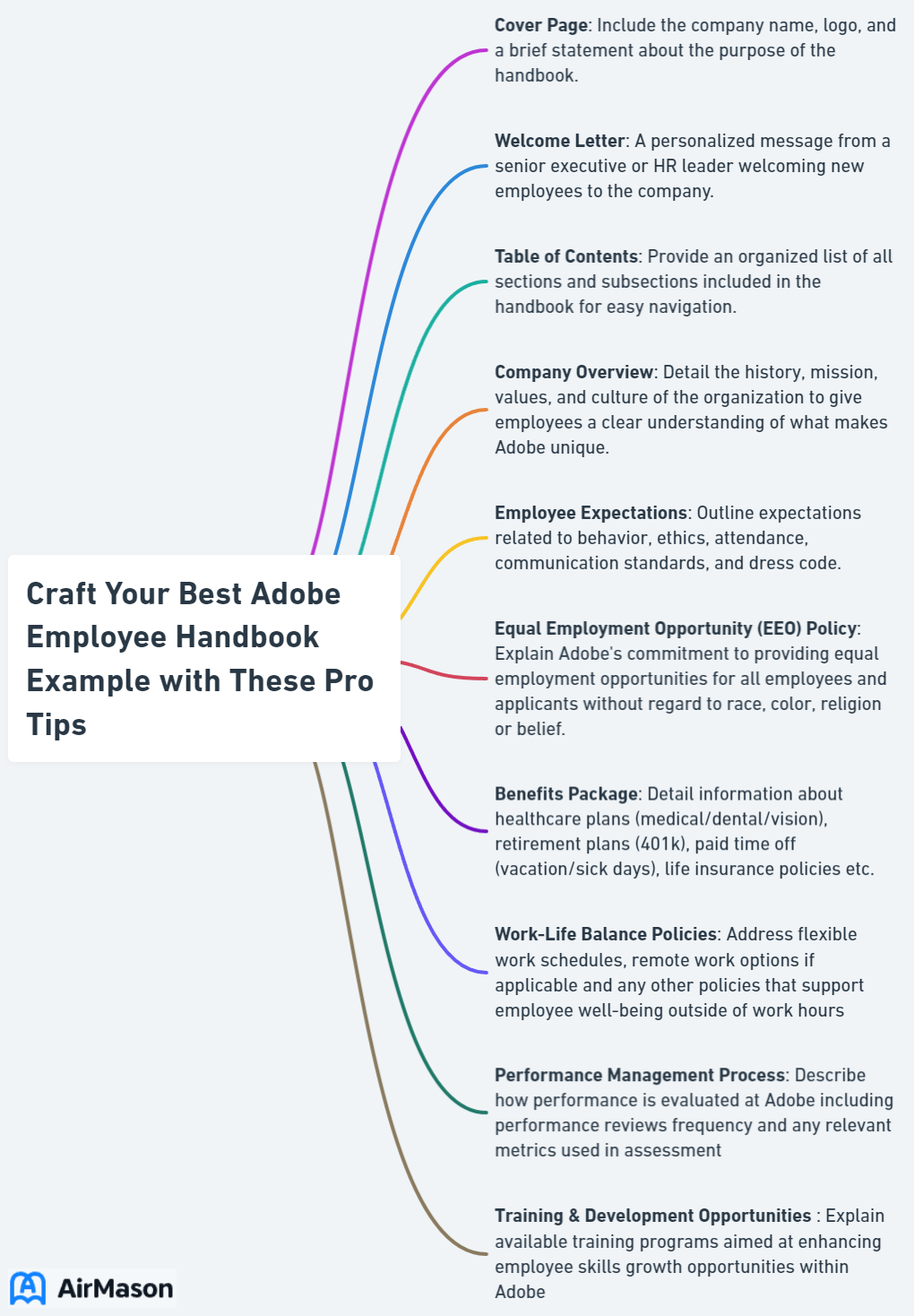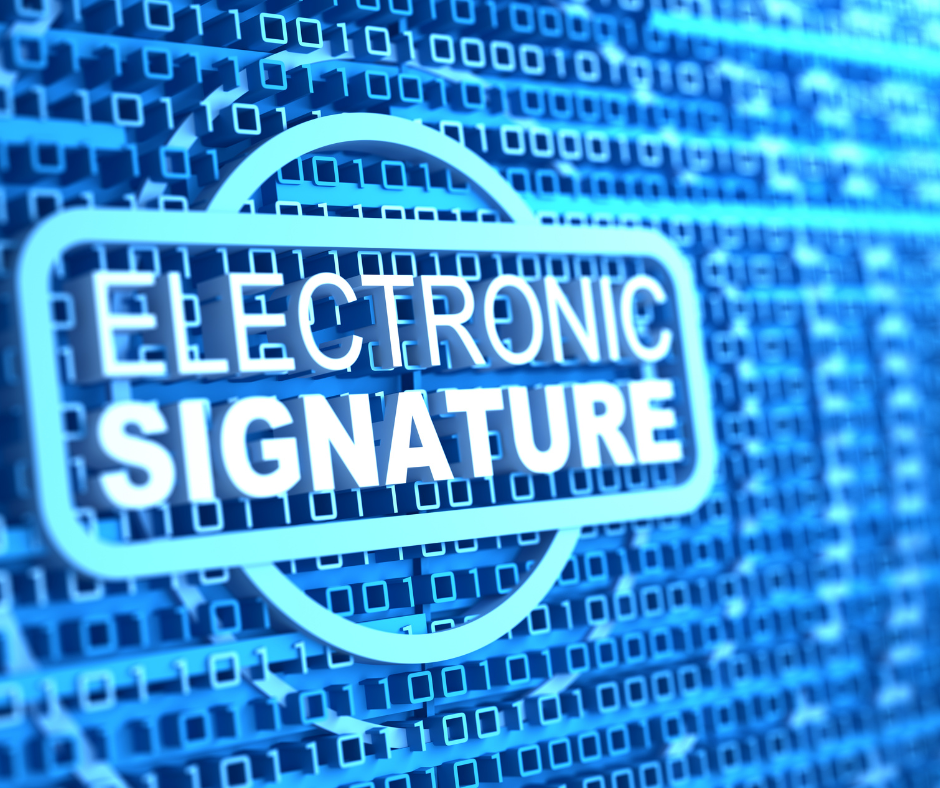
If you’re tasked with creating a professional Adobe employee handbook, understanding how to harness Adobe InDesign’s features is key. In this step-by-step guide, you’ll learn to select the right templates, customize the layout, and use Adobe’s robust typographic controls to produce a clear, well-branded employee manual. To help you get started, we will provide an Adobe employee handbook example.
Key Takeaways
- Adobe InDesign provides a customizable and professional platform for designing company handbooks, with typographic control and interactive elements to enhance readability and engagement.
- Microsoft Word can effectively organize and present company policies with clear headers, a table of contents, and visual aids, improving the usability of employee handbooks.
- Regularly updating the employee handbook is crucial for reflecting current policies and legal compliance, with the involvement of HR, legal advisors, and other stakeholders critical in the review process.
Fortune 100 Company Employee Handbook
Welcome to our esteemed Fortune 100 company, where excellence and professionalism are paramount. The Fortune 100 Company Employee Handbook serves as your comprehensive guide to navigating our organizational culture and expectations. Within the pages of this handbook, you will find essential information on company policies, employee benefits, and guidelines that shape our workplace environment. As an integral part of our workforce, we encourage you to familiarize yourself with the Fortune 100 Company Employee Handbook to ensure a harmonious and successful journey throughout your tenure. Your commitment to understanding and adhering to the principles outlined in this handbook is fundamental to our collective success.
Designing an Employee Handbook with Adobe InDesign
Adobe InDesign offers a versatile platform for creating a professional, business-aligned handbook. Thoughtful consideration of the layout and format can lead to a handbook that mirrors your company’s identity and provides an aesthetically pleasing reading experience.
Moreover, Adobe InDesign offers the following benefits for creating a handbook:
- Typographic control for easily readable content
- Customizable templates for efficient content updates
- Ability to incorporate visual elements such as images, icons, and infographics to improve engagement and readability.
Choose the Right Template
When selecting a template, consider how it aligns with your company’s culture and goals. Adobe InDesign provides brand board templates that allow you to customize fonts and colors to match your company’s branding.
For a more personalized touch, consider modifying the elements and primary colors, adapting paragraph styles, and utilizing PDF comments for feedback. This way, the template will resonate with your employer branding requirements and create an immediate connection with your employees.

Customize Your Design on AirMason’s Employee Book Builder
Adobe InDesign and AirMason’s employee handbook builder allow for easy customization of your employee handbook, including:
- Font changes to boost readability
- Adjusting the color scheme
- Applying colors to strokes or fills within the document to align the handbook’s design with your company’s brand.
To maintain consistency across the handbook, the use of Master pages standardizes headers, footers, and page numbers. Additionally, you can incorporate interactive features such as buttons and hyperlinks, elevating the handbook’s professionalism and functionality.
Streamlining Company Policies with Microsoft Word
Microsoft Word is another powerful tool that can streamline the creation and dissemination of your company policies. Incorporating headers and a table of contents can effectively outline your document’s structure, making it easier for employees to navigate through the various sections of the handbook.
Microsoft Word also offers features like policy templates and automation tools, which can streamline policy drafting, save time, and maintain consistency.
Organizing Content Effectively
Employees can easily locate necessary information in a well-structured document. Including a table of contents in your Microsoft Word document provides a comprehensive summary of the document’s sections and generates interactive links, enabling easy navigation.
Moreover, using Microsoft Word’s Navigation pane allows employees to efficiently jump between headings in the document. Consistent formatting for visual coherence and Word’s Find and Replace function for uniformity across the document can further enhance your handbook’s organization.
Incorporating Visuals

Visuals are an effective way to convey concepts and information, enhancing understanding of policies. Incorporating photographs, diagrams, and other visuals can significantly improve the readability and overall attractiveness of your handbook.
To achieve a balance between text and visuals, place relevant images close to the associated text to provide visual support. Breaking up text into bullet points or short sections can also contribute to achieving this balance, making your employee handbook a more engaging read.
PPG Industries Employee Handbook Example
In this illustrative PPG Industries Employee Handbook Example, we delve into the comprehensive guidelines and policies that govern the conduct and expectations within the organization. The PPG Industries Employee Handbook serves as a valuable resource, providing employees with clear insights into the company’s mission, values, and code of conduct. From outlining workplace protocols to detailing employee benefits and responsibilities, this handbook stands as a crucial document ensuring a harmonious and productive work environment. Employees can refer to this handbook for essential information on topics such as work hours, professional development opportunities, and the company’s commitment to diversity and inclusion. As an integral part of PPG Industries’ commitment to transparency and communication, the handbook sets the standard for fostering a positive and collaborative workplace culture.
Enhancing Employee Onboarding Experience
An integral part of the onboarding process is the employee handbook. The human resources team can automate the creation of welcome packets, allowing them to allocate more time to other essential tasks and ensuring that new hires receive consistent and comprehensive information.
An automated template streamlines this process, making the onboarding experience smoother and more efficient for both HR and new hires.
Setting Expectations
During onboarding, it is necessary to communicate the company culture and expectations clearly. This can be achieved by incorporating specific sections in the employee handbook that outline your company’s vision, values, and culture.
It’s paramount to set clear and achievable expectations for new hires. These expectations, which can include demonstrating respect, diligence, and collaborative skills, should be explicitly stated in the handbook. Establishing performance standards is another important aspect, which can be done by reviewing job descriptions, discussing measurable goals, and analyzing historical data.
Providing Essential Information

The employee handbook ought to include critical information about company policies, legal responsibilities, employment laws, and the company’s mission, vision, and values. An employee handbook template can be helpful in ensuring all these aspects are covered. Safety procedures are another crucial component, including workplace health and safety policies, emergency procedures, and procedures to address health and safety issues.
It’s also important to include key personnel contact details in the handbook. This ensures employees know who to contact in case they have inquiries, and it’s essential that this information is kept up-to-date and accurate.
Protecting Your Business with Signed Acknowledgments
Securing signed acknowledgments from employees is a key step in safeguarding your business. This ensures that each new employee confirms their receipt and understanding of the handbook content, which can be beneficial in the context of legal proceedings related to wrongful termination.
The HR team is advised to retain a copy of the signed employee handbook acknowledgments in the employee’s personnel file for the purpose of record-keeping and future reference. Moreover, when significant revisions are made to the employee handbook, it is crucial to reissue acknowledgments to ensure every employee confirms their receipt of updated information.
Electronic Signatures

Electronic signatures offer a swift and effective acknowledgment process, enabling employees to digitally confirm receipt and agreement with handbook content. Various platforms such as:
- Dropbox Sign
- DocuSign eSignature
- Acrobat Sign
- signNow
We offer the essential tools for securely capturing electronic signatures using a computer, making the search for a reliable solution effortless.
Electronic signatures are legally recognized as possessing equivalent validity to handwritten, paper-based signatures when specific conditions are met. This eliminates the necessity of in-person document signing, enhancing operational efficiency, and reducing paper consumption.
Tracking and Storing Signed Documents
Secure tracking and storage of signed documents are vital to compliance and legal risk reduction. Here are some effective strategies to monitor signed documents:
- Implement a suitable document management system
- Assign roles to internal and external stakeholders
- Establish transparent document control policies
- Utilize document tracking software
By following these strategies, you can ensure the secure tracking and storage of signed documents.
Numerous software options are available for securely storing signed documents, such as BlueInk, PandaDoc, HoneyBook, Concord, Formstack Sign, ContractSafe, WikiPro, M-Files, and DocuSign.
Digital storage of signed documents also guarantees the integrity of the message’s contents during transmission, thereby safeguarding the agreement from unauthorized alterations and verifying users.
Keeping Your Employee Handbook Up-to-Date
An updated employee handbook is necessary to accurately mirror current policies, minimize potential legal issues, and display the company’s culture. To ensure that your handbook remains current and relevant, it is recommended to review it at least once a year.
Involving key stakeholders during revision ensures a thorough update that encompasses all perspectives and areas of expertise. Some key stakeholders to consider include:
- HR personnel
- Legal advisors
- Department heads
- Employees
Input and feedback from these stakeholders can be invaluable in the edit and revision process.
Schedule Periodic Reviews
Conducting periodic reviews helps maintain the handbook’s relevancy. A systematic review involves:
- Ensuring all necessary information is available
- Reviewing key topics for compliance
- Checking for updates on multi-state laws and regulations
- Making any necessary annual updates
- Engaging relevant stakeholders in the review process.
Indicators that suggest the need for an update include discrepancies between handbook policies and real-life situations, as well as changes in company policies or employment laws. To integrate feedback into the review process, encourage feedback from employees, utilize multiple and consistent feedback mechanisms, and establish a system for employee recognition and grievance resolution.
Block Employee Handbook Example
In this Block Employee Handbook Example, we aim to provide a comprehensive guide outlining the policies and procedures that govern our organization. The Block Employee Handbook serves as a crucial resource for our employees, offering insights into our company culture, expectations, and the framework that defines our professional environment. From guidelines on workplace conduct to information about benefits and resources, this handbook is designed to empower our employees with the knowledge they need to thrive within our organization. By familiarizing yourself with the Block Employee Handbook, you ensure a smooth integration into our workplace community, fostering a positive and productive experience for both you and your colleagues.
Involve Key Stakeholders
The involvement of key stakeholders in the development and revision of the handbook guarantees it accurately represents company policies and expectations.
Management has a significant part in ensuring the handbook is an accurate reflection of current policies and procedures. This includes:
- Maintaining legal compliance
- Ensuring relevance and accuracy
- Aligning it with the current state of operations
- Setting general expectations.
Summary
In conclusion, crafting an effective employee handbook can be a rewarding endeavor. Leveraging Adobe InDesign and Microsoft Word can greatly simplify the process, allowing you to create a visually appealing, easy-to-navigate handbook that accurately reflects your company’s culture and policies. Regular reviews and updates ensure that your handbook remains current and relevant. Remember, your employee handbook is not just a document—it’s a powerful tool that sets the tone for your company culture, clarifies policies, and helps onboard new hires effectively.
Frequently Asked Questions
How often should an employee handbook be reviewed?
It’s important to review an employee handbook at least once a year to ensure it stays current and relevant.
Why is it important to obtain signed acknowledgments from employees for the handbook?
It is important to obtain signed acknowledgments from employees for the handbook because it ensures that each new employee confirms their receipt and understanding of the handbook content, which can be beneficial in the context of legal proceedings related to wrongful termination. This helps protect both the employer and the employee.
What role does management play in updating the employee handbook?
Management plays a crucial role in updating the employee handbook by ensuring it accurately reflects current policies, maintains legal compliance, and sets general expectations for employees. This helps in aligning the handbook with the current state of operations.
How can electronic signatures be used for employee handbook acknowledgments?
Electronic signatures provide a quick and effective way for employees to digitally confirm receipt and agreement with handbook content, streamlining the acknowledgment process.
What are the benefits of using Microsoft Word for organizing company policies?
Using Microsoft Word for organizing company policies offers simplified policy creation, consistency across policies, and effective organization of content in the employee handbook. It is a valuable tool for streamlining policy management and ensuring clarity for employees.
Important Disclaimer:
The article presented here does not serve as a representation of the company’s actual employee handbook mentioned in this article.
Our discussions and insights regarding employee handbook are based on assumptions about what may be considered significant in the companies’ policies. These assumptions are drawn from available information and industry knowledge. Readers are advised that the content provided is for informational purposes only and should not be construed as an exact reflection of any company’s official policies or procedures. For precise and accurate details regarding a company’s employee handbook, individuals should refer directly to the company’s official documentation or consult with appropriate representatives.
Please be aware that the content on this page has been generated by using artificial intelligence language models and may contain errors, inconsistencies, or outdated information. It is provided as-is without any warranties or guarantees of accuracy. We strongly recommend using this content as a starting point for further research. We disclaim any liability for damages or losses resulting from the use or reliance on this content.